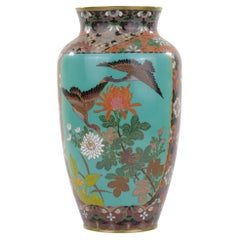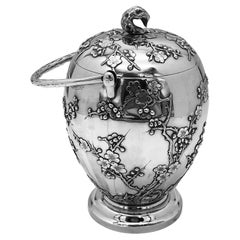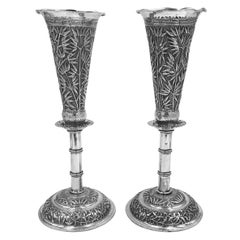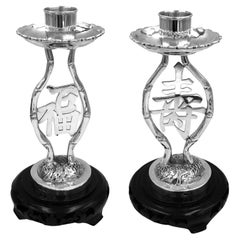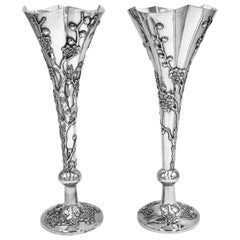Late 19th Century Metalwork
to
48
217
145
382
11
5
1
126
883
845
27
441
182
56
40
12
20
8
10
8
23
10
5
1
380
144
110
87
83
357
300
222
75
30
382
382
382
12
4
3
3
2
Period: Late 19th Century
Patinated Bronze Vase With A Lizard Carved In Relief In The Center
Located in Milano, IT
Patinated bronze vase, characterized by a refined naturalistic decoration with a lizard sculpted in relief in the center. The lizard is placed on leaves overlapping each other creati...
Category
Japanese Japonisme Antique Late 19th Century Metalwork
Materials
Bronze
$3,160 Sale Price
20% Off
Antique Japanese Meiji Era (c1880) Cloisonné Vase Geese in Flight & Flowers 12”
Located in Portland, OR
Available from Shogun's Gallery in Portland, Oregon for over 40 years specializing in Asian Arts & Antiques.
This is a beautiful Japanese Meiji era (c. 1870-90's) ornate cloisonné v...
Category
Japanese Antique Late 19th Century Metalwork
Materials
Copper, Enamel
Chinese Export Silver Biscuit Box
Located in London, GB
A Chinese Export Silver Biscuit Box, round with a collet foot and profusely decorated with applied prunus. against a smooth plain background. The box has...
Category
Chinese Chinese Export Antique Late 19th Century Metalwork
Materials
Silver
Pair of Chinese Export Silver Vases
Located in London, GB
Pair of Chinese silver vases with all-over bamboo decoration and each with a wavy-edge flared rim. They were made by 涂茂兴, TuMaoXing, a retailer in JiuJiang (九江), next to the Yangtze ...
Category
Chinese Chinese Export Antique Late 19th Century Metalwork
Materials
Silver
$2,725 / set
Pair of Chinese Export Silver Candlesticks
Located in London, GB
Pair of Chinese Export silver candlesticks with the character for "Luck" on one and "Longevity" on the other. They are attached to round wood stands.
Marked with SW, for Shing Wo, “...
Category
Chinese Chinese Export Antique Late 19th Century Metalwork
Materials
Silver
$5,110 / set
Pair of Chinese Export Silver Vases
Located in London, GB
A Pair of Chinese Export Silver Flower Vases of trumpet form, each with circular base and rising to a flared, shaped top. The vases, which are decorated with applied prunus, were ret...
Category
Chinese Chinese Export Antique Late 19th Century Metalwork
Materials
Silver
$3,406 / set
Pair of Chinese Export Silver Candlesticks
Located in London, GB
A pair of Chinese Export silver candlesticks, marked with TC, for Tuck Chang, 德祥 公记(DeXiangGongJi), a Shanghai retailer from 1901-1934, and with the maker's mark of 培记 (PeiJi).
230gm...
Category
Chinese Chinese Export Antique Late 19th Century Metalwork
Materials
Silver
$2,997 / set
Two Chinese Export Silver Vases
Located in London, GB
Two Chinese silver vases of cornucopia form, both decorated with applied bamboo and chrysanthemum and on a circular base. The vases are similar yet were made by different silversmith...
Category
Chinese Chinese Export Antique Late 19th Century Metalwork
Materials
Sterling Silver
$3,406 / set
A bronze okimono depicting a study of a puppy playing with a ball
Located in Milano, IT
Bronze okimono depicting a study of a puppy playing with a ball.
The puppy has a playful and curious expression as he interacts with the ball.
The...
Category
Japanese Japonisme Antique Late 19th Century Metalwork
Materials
Bronze
$2,830 Sale Price
20% Off
Japanese Silver Bowl with Irises by Konoike, Meji Period
Located in Sarasota, FL
Japanese silver bowl with handles by Konike. Finely decorated with repousse irises and cast floral handles. Marked on the bottom for the maker.
Weight 272 g or 8.7 t.oz
Category
Japanese Antique Late 19th Century Metalwork
Materials
Silver
A Cloisonné hexagonal potiche
Located in Milano, IT
Cloisonné potiche with a hexagonal shape, embellished with delicate floral decorations on reserves held by silver threads with geometric motifs. The lid features a spherical socket.
...
Category
Japanese Japonisme Antique Late 19th Century Metalwork
Materials
Metal
$1,415 Sale Price
20% Off
A small fine quality Meiji period cloisonné enamel vase
Located in Lymington, Hampshire
A small fine quality Meiji period cloisonne enamel vase, with silver wires and gilt rims decorated with lappets of dragons of ho-ho birds on a brown ground, with textile designs arou...
Category
Japanese Meiji Antique Late 19th Century Metalwork
Materials
Metal
Owl on a Tree Stump
Located in PARIS, FR
Bronze sculpture representing an owl on a tree stump covered with ivy. The owl, detachable from its base, has shakudo eyes. It is certainly an Ryûkyû scops ...
Category
Japanese Antique Late 19th Century Metalwork
Materials
Bronze
$16,510
A Japanese drop-shaped bronze vase with peonies
Located in Milano, IT
Drop-shaped bronze vase, with peonies in relief, decorated to simulate a delicate and light fabric that ends with a bow near the top of the neck.
Using mixed metals to create visual...
Category
Japanese Japonisme Antique Late 19th Century Metalwork
Materials
Bronze
$2,924 Sale Price
20% Off
Japanese Bronze Hawk Ikebana
Located in PARIS, FR
Bronze intended for hanging (? dô kakenanaike, « hanging bronze ») depicting a hawk, placed on a branch. The inside is hollow so a bouquet a flowers can be put inside and thus, serve...
Category
Japanese Antique Late 19th Century Metalwork
Materials
Bronze
A large Islamic bronze urn
Located in Southall, GB
A wonderful Cyrian bronze urn, handmade in the Middle East with engravings around the whole of the urn. With beautiful circular solid bronze handles. Some age related dents .
Possib...
Category
Antique Late 19th Century Metalwork
Materials
Bronze
$2,180 Sale Price
27% Off
Chinese Silver Repousse and Cast Goblet by Wang Hing.
Located in Sarasota, FL
Chinese silver repousse goblet by Wang Hing. Depicts Chinese garden scenes. Drgon base with emanating fire. Marked WH for Wang HIng maker and 90 Chinese silver. Weight 7.4 oz
Category
Chinese Antique Late 19th Century Metalwork
Materials
Silver
Large Bronze Tibetan Vase with Handles
Located in Alessandria, Piemonte
Large Tibet bronze and copper vase with handles: exceptional and perfect.
Sizes: diameter at the top cm. 52, with handles cm. 61. Base 35 cm.
High cm. 43....
Category
Tibetan Other Antique Late 19th Century Metalwork
Materials
Bronze
Group of Fourteen Japanese Meiji Period Gilt Metal Plaques
Located in London, GB
Group of fourteen Japanese Meiji period gilt metal plaques
Japanese, Late 19th Century
Height 2cm, width 2cm
These beautiful Japanese Meiji period plaque...
Category
Japanese Meiji Antique Late 19th Century Metalwork
Materials
Metal
Chinese Export Silver Openwork Dragon Bowl by Wang Hing & Co, Hong Kong, 1890
Located in Sarasota, FL
Chinese silver repousse and openwork bowl, decorated with dragons and flaming pearl. The bowl is marked on the bottom with a Chinese character, "90" for silver purity, and "WH" for W...
Category
Chinese Chinese Export Antique Late 19th Century Metalwork
Materials
Silver
19th Century Meiji Period Bronze Vase with Two Frogs
Located in Lymington, Hampshire
A Meiji period bronze vase with two frogs against a rough textured ground, signed ‘Hyakusei’, Japanese, circa 1880.
Category
Japanese Meiji Antique Late 19th Century Metalwork
Materials
Bronze
A Monumental Gilt-Lacquered Bronze Ornamental Buddha Sculpture of Vajravidarana
Located in Queens, NY
A Monumental Gilt-Lacquered Bronze Ornamental Buddha Sculpture of Vajravidarana:
A Masterpiece of Sino-Tibetan Craftsmanship, Late 19th Century, Qing Dynasty
This monumental gilt-lacquered bronze ornamental sculpture of Vajravidarana is an extraordinary and commanding piece of art, showcasing the pinnacle of Sino-Tibetan craftsmanship from the late 19th century. The figure of Vajravidarana, a powerful purification deity in Tibetan Buddhism, is meticulously sculpted to embody both spiritual authority and artistic excellence.
Vajravidarana is primarily known for his role in removing spiritual impurities and negativities. Unlike other deities associated with wisdom or compassion, Vajravidarana’s function is centered on purification and healing. He is typically depicted holding a vajra and a bell, symbolizing the cutting away of delusions and the resonance of divine truth. In this striking sculpture, Vajravidarana is shown holding a vishva vajra (the double vajra), a unique and powerful variation of the traditional iconography, which signifies ultimate protection and the dispelling of negative karma.
Vajravidarana: The Supreme Purifier and Protector
Vajravidarana is revered in Tibetan Buddhism as the deity of spiritual purification, called upon to cleanse practitioners of defilements and negative influences. His vajra represents the indestructibility of truth, while his bell signifies the wisdom that resonates through purification rituals. In this sculpture, the presence of the vishva vajra, or double vajra, enhances his association with supreme protection, ensuring the destruction of all spiritual obstacles and afflictions.
The figure’s powerful yet composed expression conveys a sense of unwavering resolve and divine authority. His posture, along with the carefully sculpted details of his robes and ornaments, highlights his function as a guardian against impurity. The inclusion of the vishva vajra rather than the usual single vajra reinforces his role as a supreme protector, capable of dispelling all forms of negativity and restoring balance.
Symbolism of the Mantras and Aureole:
Unlike deities that embody wisdom through duality, Vajravidarana’s iconography is centered on purification and exorcism. The aureole surrounding him is inscribed with sacred purification mantras rather than depictions of a consort. These mantras emphasize his function as a remover of obstacles and impurities, reinforcing his role in Buddhist healing rituals.
The presence of the sacred inscriptions elevates the sculpture’s spiritual significance, making it a focal point for meditation and ritual purification. Practitioners often visualize Vajravidarana radiating purifying light, dissolving afflictions and negative karma. This theme is mirrored in the sculptural repetition of the purification symbols on the aureole, reinforcing the deity’s role as a divine cleanser.
Gilt-Lacquered Bronze: The Artistry of Sino-Tibetan Metalwork:
The craftsmanship of this monumental figure reflects the expertise of late 19th-century Sino-Tibetan metalwork, where traditional Tibetan themes were infused with Chinese artistic sensibilities. Cast in bronze and finished with a rich gilt lacquer, the statue has an otherworldly glow, giving it an ethereal, almost divine presence. The gilding process—applied with exceptional skill—gives the sculpture a striking luminosity that enhances the fine details of the facial features, flowing robes, jewelry, and other elements of the deity’s attire.
The technique employed to create this figure speaks to the high level of craftsmanship that flourished during the late Qing Dynasty and early modern Tibetan art. The ornate details of the robes and the fine texture of the sculpture highlight the exceptional skill of the artisans who brought this work to life. The use of gold and lacquer not only reflects the preciousness of the sculpture but also its spiritual significance as an object meant to inspire reverence and meditation.
An Ornamental Sculpture of Monumental Scale:
Unlike smaller devotional objects, this sculpture is designed as an ornamental masterpiece, intended to make a grand visual and spiritual statement. Its monumental size allows it to dominate any space, offering a commanding presence that is both physically and symbolically impressive. In Buddhist practice, large sculptures of this nature are often placed in temples or meditation halls, where their imposing size and serene presence would encourage contemplation and devotion.
The grand scale of the statue further amplifies the spiritual power it is meant to convey. As a representation of Vajravidarana, it is not only a physical object of beauty but also a conduit for meditation, purification, and enlightenment. The scale of the sculpture also emphasizes the divine stature of the deity, highlighting his importance in the Buddhist tradition as the ultimate force for spiritual cleansing and protection.
Provenance:
Acquired in China in circa 1900
1905 Private Buddhist Temple, Northeast, USA
Private Sale
Solomon Treasure...
Category
Chinese Tibetan Antique Late 19th Century Metalwork
Materials
Bronze

